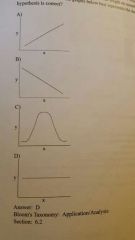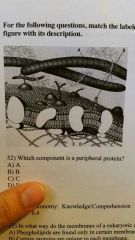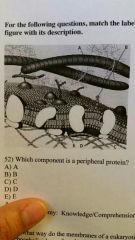![]()
![]()
![]()
Use LEFT and RIGHT arrow keys to navigate between flashcards;
Use UP and DOWN arrow keys to flip the card;
H to show hint;
A reads text to speech;
12 Cards in this Set
- Front
- Back
|
A phospholipid is a... |
Nonpolar lipid molecule that is made amphipathic by the addition of a phosphate |
|
|
What region of a steroid is hydrophilic? |
The terminal hydroxyl group |
|
|
Cooking oil and gasoline (a hydrocarbon)are not amphipathic molecules because they... |
Do not have a polar or charged region |
|
|
Phospholipids and triglycerides both... |
Have a glycerol backbone |
|
|
Lipids... |
Are insoluble in water |
|
|
Which of the following is a large organic molecule that is NOT assembled by polymerization of a few kinds of simple subunits? |
A steroid |
|
|
Steroids are considered to be lipids because they... |
Are not soluble in water |
|
|
The presence of cholesterol in the plasma membranes of some animal cells... |
Enables the membranes to stay fluid when cell temperature drops |
|
|
You make a phospholipid bilayer with short, saturated hydrocarbon tails. You measure the permeability of this membrane to oxygen. You then double the length of the hydrocarbon tails,and remeasure membrane permeability. You then double the length of the hydrocarbon tails again, and make a third measurement of membrane permeability. You graph membrane permeability as a function of hydrocarbon tail length. Which of the graphs below best represents the data you expect? |

|
|
|
You make a phospholipid bilayer with short, saturated hydrocarbon tails. You measure the permeability of this membrane to oxygen. You are going to change the length of the hydrocarbon tails and remeasure membrane permeability, but first your boss asks you to graph the data you expect if there is no effect of hydrocarbon tail length on membrane permeability (your null hypothesis). Which of the graphs below best represents the data you expect if your null hypothesis is correct? |

|
|

Which component is a peripheral protein? |
D. |
|

In what way do the membranes of a eukaryotic cell vary? |
Certain proteins are unique to each membrane |

